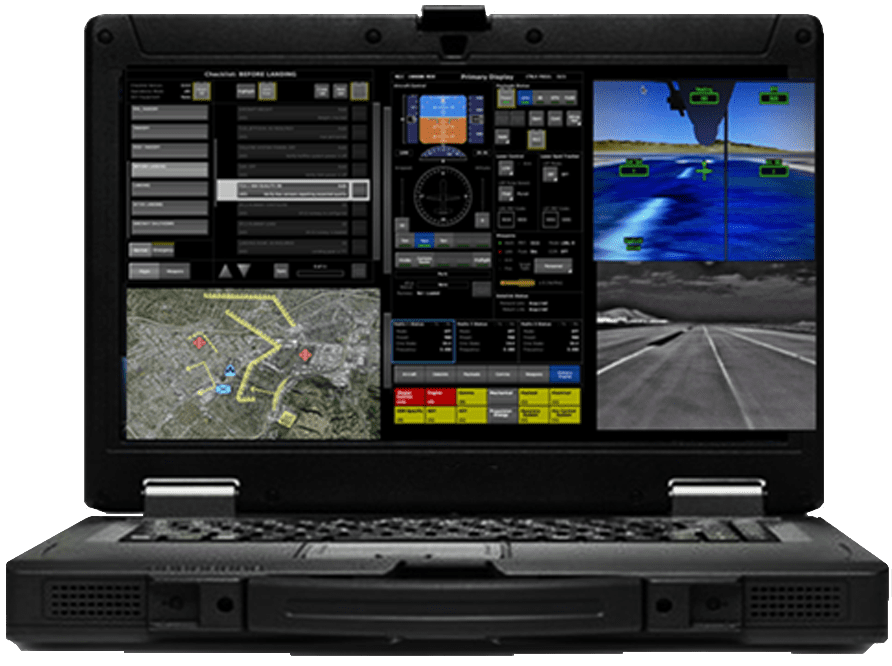
A ruggedized laptop showing GA-ASI’s expeditionary command-and-control product, enabling automatic pre-flight. (GA-ASI)
General Atomics’ MQ-9B SkyGuardian completed a demonstration sortie without the use of an on-site ground control station (GCS) this month, relying on only satcom and the company’s expeditionary command-and-control (XC2) portable laptop.
One of the MQ-9B’s selling points is the ability to cut down the system’s footprint by launching without an on-site GCS, which is what GA-ASI demonstrated on Feb. 15.
The company used its XC2 portable laptop to complete preflight checks. XC2 is part of GA-ASI’s Heresy program and allows for the automation of the preflight process and manual taxi. Another step of the program, multi-mission control, looks to expand that functionality out to coordinate and control multiple drones at once.
After preflight checks, control of the MQ-9 was handed off to a remote GCS via satellite communication for taxi and automatic takeoff, flight and landing, using only the satcom datalink. At that point, the XC2 laptop took control to complete post-flight and shutdown.
“Using a portable laptop computer in conjunction with satcom taxi and automatic-takeoff-and-landing capability is a game-changer for our customers,” said David R. Alexander, GA-ASI’s president of aircraft systems. “Instead of having a forward GCS relying on line-of-sight communication, this advanced capability greatly reduces manpower and ensures that the remote pilots can be far away from any potential conflict.”
GA-ASI claims that use of the XC2 laptop’s automation can reduce preflight check time by up to 50 percent.

A General Atomics MQ-9B SkyGuardian in flight. (GA-ASI)
The MQ-9B, which is available in both a SkyGuardian and SeaGuardian version, is a derivative of General Atomics Aeronautical Systems’ (GA-ASI) MQ-9 Predator B, or Reaper, large UAS, developed to meet NATO’s STANAG 4671, the organization’s “UAV system airworthiness requirements” which mandate sense-and-avoid capabilities. The U.K.’s Royal Air Force and Belgium’s military have both selected the SkyGuardian for purchase, while Australia is undecided between the MQ-9A and MQ-9B and expected to decide in this year.
“MQ-9B is the world’s only [remotely piloted aircraft] being developed to be certified to fly in non-segregated, controlled airspace,” said GA-ASI CEO Linden Blue in a statement Monday. “The development is the result of a five-year, company-funded program to deliver an unmanned aircraft to meet the stringent airworthiness type-certification requirements of NATO and various civil authorities.”
The sense-and-avoid system GA-ASI is providing for the MQ-9B to meet NATO requirements consists of air-to-air radar, traffic alert and collision avoidance system and ADS-B, according to the company.
Before now, GA-ASI has shown off the MQ-9B’s ability by flying it nonstop across the Atlantic, from Grand Forks, North Dakota, to Gloucestershire, U.K. — a 3,760 nautical mile journey — over 24 hours.
The drone features 40-plus hours of endurance and a 6,000 nautical mile range, with multiple payload options to fill 4,000 lbs. of carrying capacity across nine hardpoints. To satisfy mission requirements such as intelligence, surveillance and reconnaissance and search and rescue, the MQ-9B also has the company’s Lynx multi-mode synthetic aperture radar, which provides high-resolution imagery with a wide search area and electro-optical/infrared capabilities.
GA-ASI says that MQ-9B development is continuing without delay and first delivery is expected to the U.K. in the early 2020s.